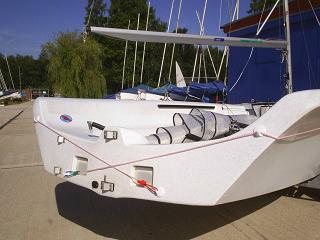A Righting Line To Help Right A Boat
by Peter
(Lancaster)

A righting line on aboat (I would advise it to go slightly higher up the hull)
I have a Miracle dinghy which inverted last week and the centreboard went in. Where is the best place to postion a righting line?
Thanks
Peter
Hi Peter
At school, we sail 420s (which you may or may not may have gathered from this website) and they have righting lines.
In case there are people reading this who don't know what a righting line is, it is a rope that helps you pull the boat up when it capsizes or inverts and especially if the centreboard goes in or if you fall off the boat.
On the 420s the righting line goes right underneath the lip of the hull (the area where you sit on - under that). It then connects to the back of the boat and the front of the boat by knots.
I was searching on Google Images to find a good example and the one above is a great example of how to connect it to the boat, without drilling any holes in the hull or damaging it in a any way.
So to answer your question, the righting line should be as close to the side of the boat as possible and just under the lip of the place you sit on when hiking out.
Thanks for asking! Best Regards,
Alex


